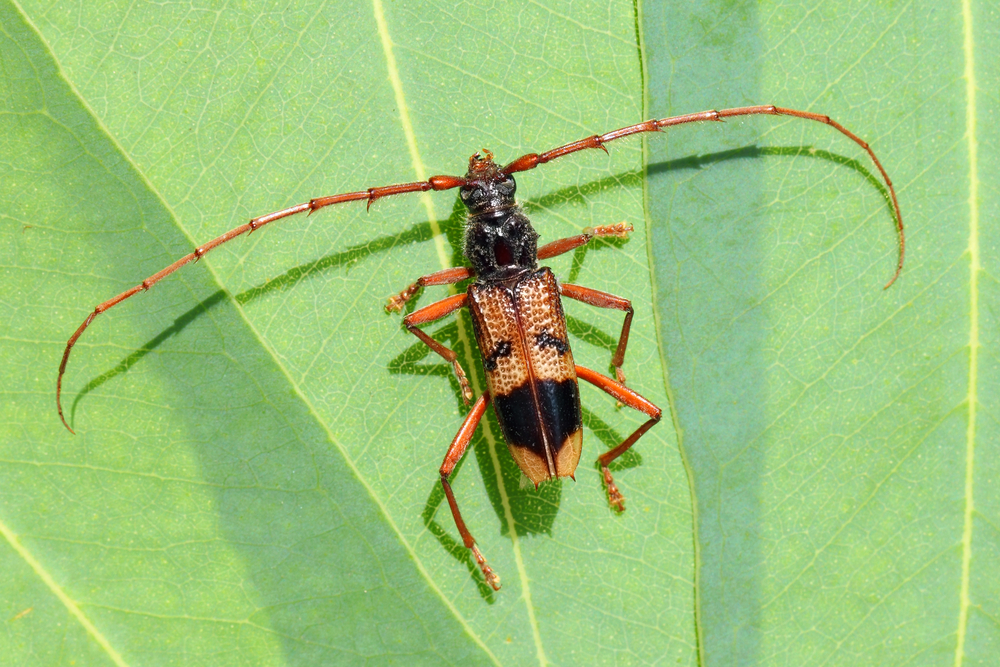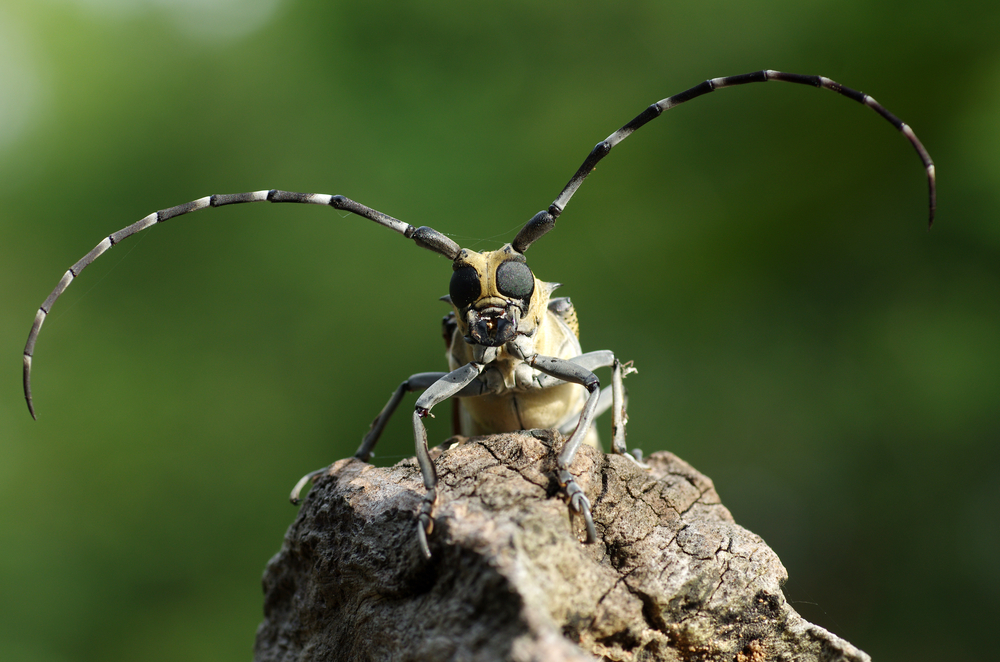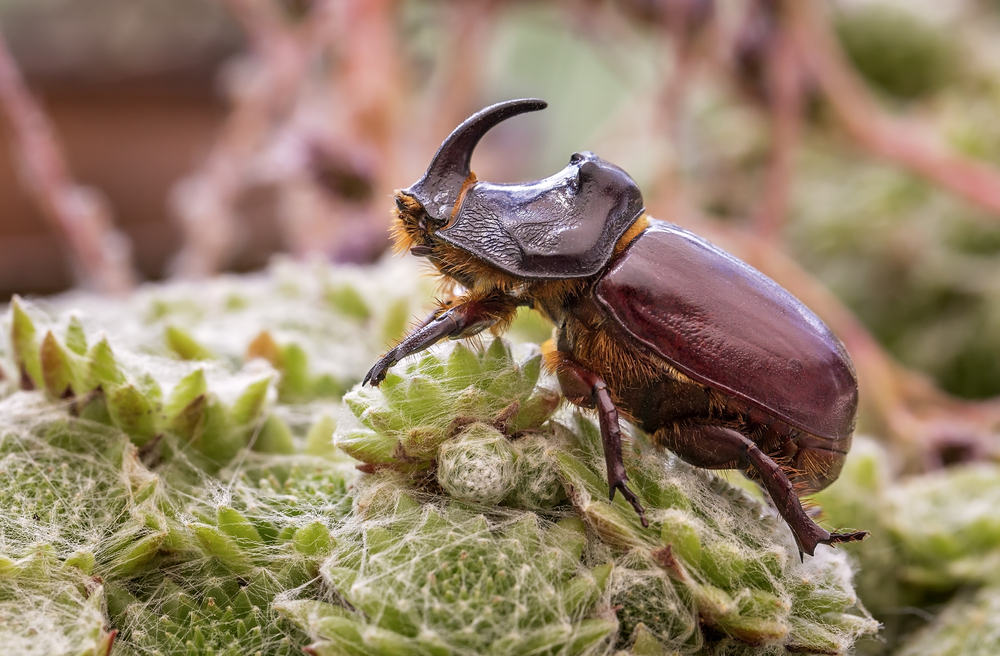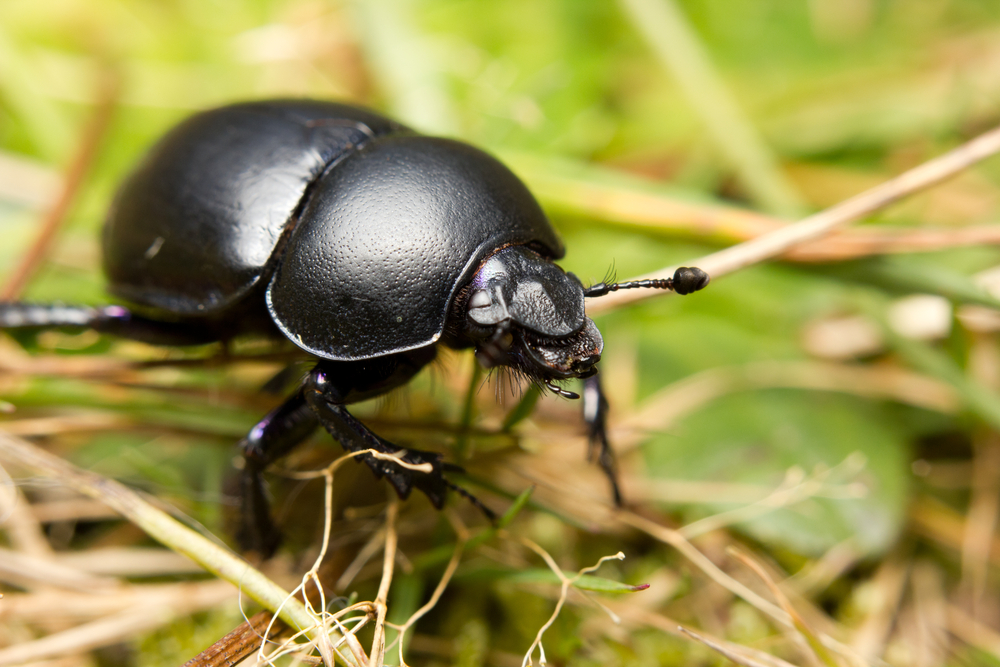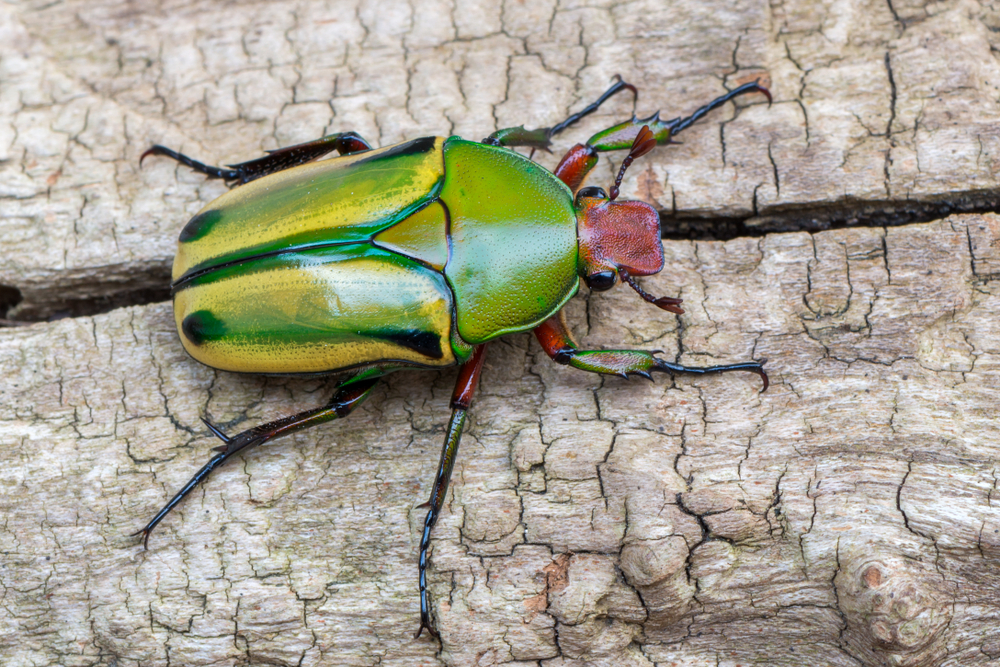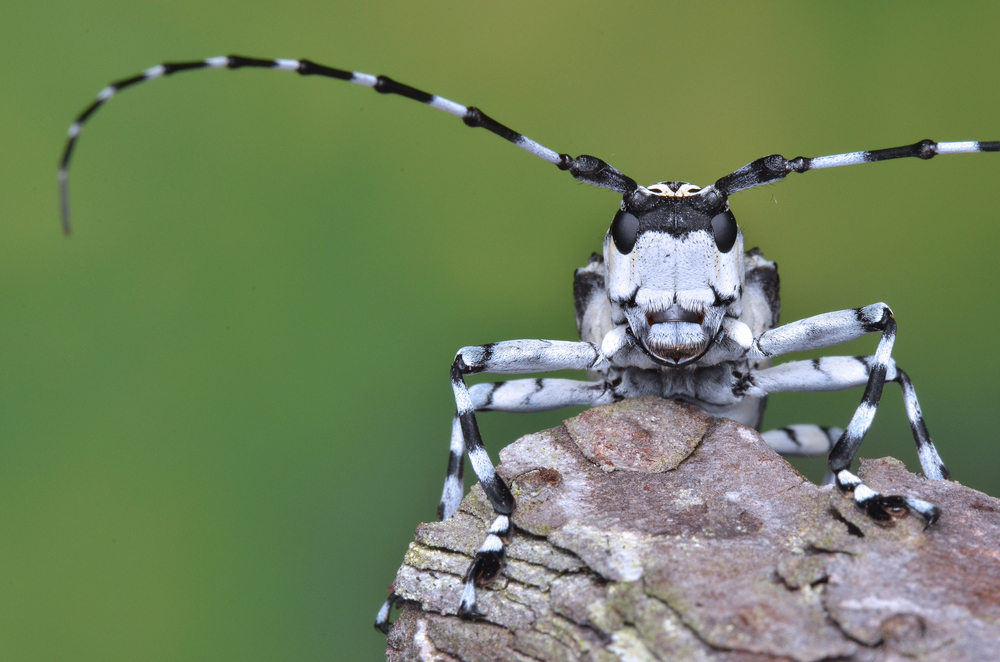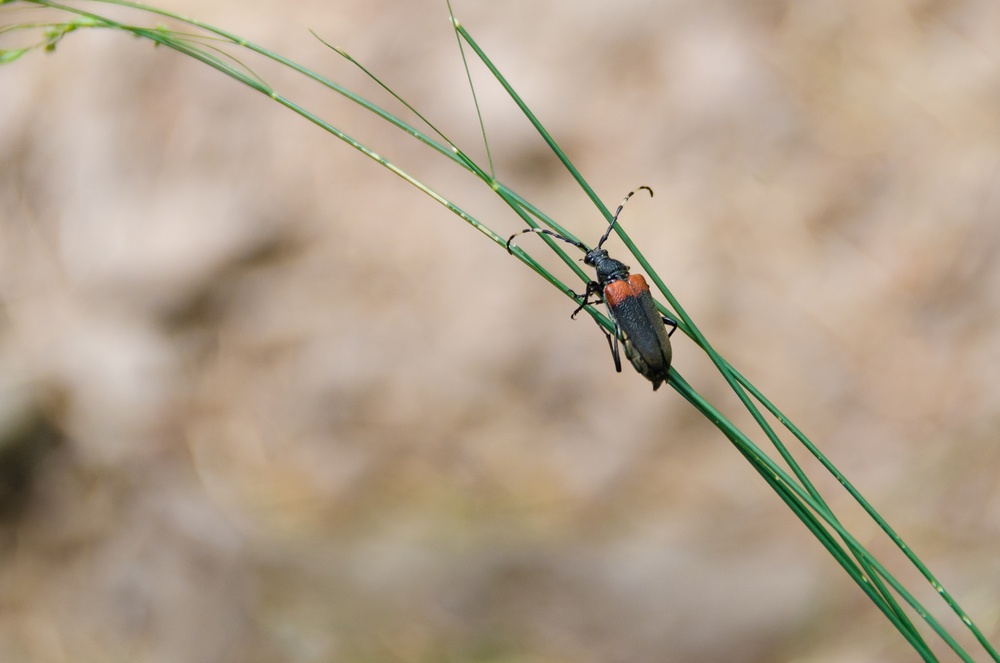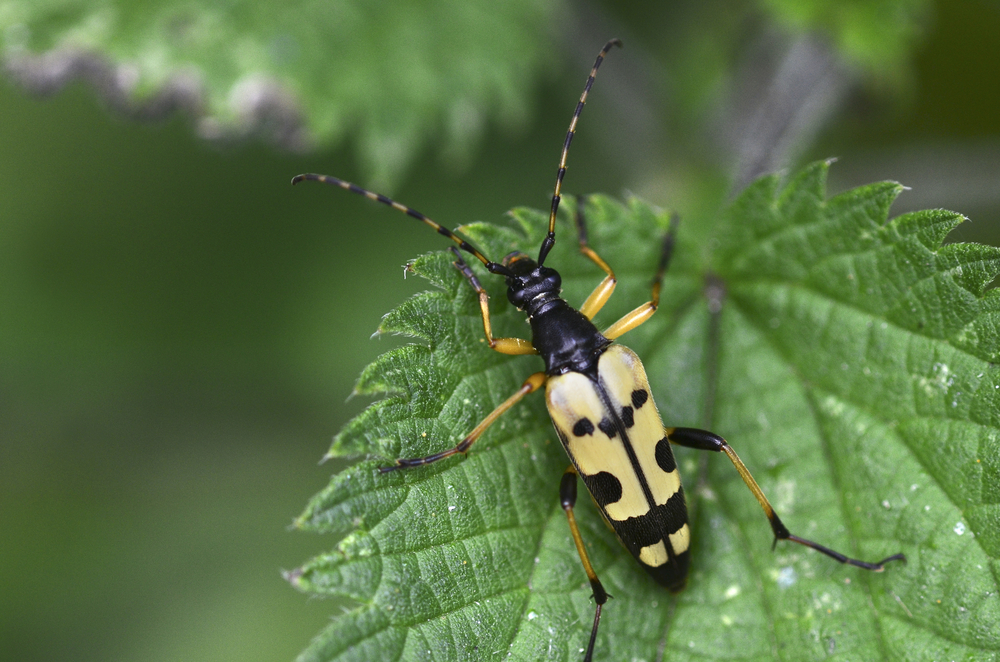There are approximately 35,000 known species of Longhorn Beetles (family Cerambycidae), making them one of the largest beetle families.
About
The Longhorn beetle, belonging to the family Cerambycidae, is a captivating group of insects celebrated for their distinctively elongated antennae, often as long as or longer than their bodies. These beetles, nestled within the order Coleoptera of the Animal Kingdom, boast a remarkable array of over 20,000 species worldwide, inhabiting diverse ecosystems from dense forests to arid deserts. Their name, Cerambycidae, is derived from the Greek word ‘keramos,’ meaning horn, a nod to their most striking feature.
Longhorn beetles exhibit a wide range of sizes, colors, and patterns, with some species showcasing vibrant hues and intricate markings on their hard, protective wing covers (elytra). These beetles are not only recognized for their aesthetic appeal but also for their significant ecological roles.
The larvae, known as woodworms, typically bore into wood, playing a crucial role in breaking down and recycling dead and decaying timber, contributing to the health of forest ecosystems. Adult longhorn beetles, on the other hand, are often found on flowers and foliage, where they feed on nectar, pollen, or leaves.
The life cycle, unique morphology, and ecological contributions of longhorn beetles make them a fascinating and integral part of the natural world. Their presence, from intricate larval tunnels in wood to the adults’ conspicuous antennas, underscores the incredible diversity and adaptability inherent in the Animal Kingdom.
Conservation Concerns
While many species of longhorn beetles are widespread and abundant, some are threatened by habitat loss, pollution, climate change, and invasive species. Deforestation and urbanization can disrupt their natural habitats, reducing available food sources and breeding sites. Pesticides and other chemical pollutants can also harm longhorn beetle populations by contaminating their food sources and disrupting their reproductive cycles.
Despite their ecological importance, longhorn beetles are often overlooked in conservation efforts, with limited research and monitoring focused on their populations. As a result, the conservation status of many longhorn beetle species remains unknown, and they are not assessed on the IUCN Red List.
Physical Characteristics
Longhorn beetles are known for their distinctive physical appearance, characterized primarily by their notably elongated antennae, often as long as or exceeding the length of their bodies. These beetles have a robust and elongated body structure, with a hard exoskeleton that varies in color and pattern among species. Some exhibit muted tones of brown or black, while others display vibrant colors and intricate patterns. Their wing covers (elytra) are typically hard and protective, covering the flight wings and the soft abdomen underneath.
Physical characteristics of longhorn beetles, including size and weight, can vary significantly among the different species within the Cerambycidae family:
- Size:
- Length: Longhorn beetles range widely in size. They can be as small as 0.2 inches (5 mm) and as large as 6 inches (15 cm) in length, with many species falling somewhere in between.
- Width and Height: Their width and height are proportionate to their length, contributing to their overall elongated and cylindrical appearance.
- Weight:
- Due to their varied sizes, the weight of longhorn beetles can also vary. However, like most insects, they are relatively lightweight. They typically weigh a few grams, with larger species possibly weighing more.
The long antennae, diverse coloration, and robust body of longhorn beetles make them a subject of interest and often a focus of study in entomology. Despite their varied appearance, all longhorn beetles share the family’s characteristic trait of long antennae, setting them apart in the vast world of Coleoptera.
Reproduction
The reproductive cycle of longhorn beetles is closely tied to their habitat and lifestyle, particularly their association with wood. Here’s a general overview of their reproductive process:
- Mating: Adult longhorn beetles typically emerge in the warmer months, ready to mate. Many species use visual and chemical cues to find a mate. The males often use their long antennae to sense pheromones emitted by the females.
- Egg-Laying: After mating, female longhorn beetles lay their eggs in or on the bark of trees, or directly into crevices or cracks in the wood. The choice of tree species and the specific part of the tree where eggs are laid depend on the longhorn beetle species. The number of eggs laid varies among species but generally ranges from a few dozen to several hundred.
- Larval Stage: Once the eggs hatch, the larvae (grubs) bore into the wood. This larval stage is the longest and most crucial part of the longhorn beetle’s life cycle. The larvae feed on the wood, creating complex tunnel systems as they grow. This process can last from several months to several years, depending on the species and environmental conditions. The larvae go through several instars, shedding their exoskeleton and growing larger each time.
- Pupation: After completing their growth, the larvae pupate within the wooden tunnels they’ve created. The pupal stage can last several weeks to several months, during which the larva transforms into an adult beetle.
- Emergence of Adults: Adult longhorn beetles emerge from the pupal stage and exit the wood. They spend their adult life feeding, mating, and for some species, laying eggs to begin the cycle anew.
The gestation period, referring to the time it takes for the eggs to hatch, is relatively short, usually a few weeks. However, the subsequent larval stage is notably lengthy and is where the most significant growth and development occur.
The long developmental phase inside wood makes longhorn beetles important decomposers in forest ecosystems, aiding in the breakdown and recycling of nutrients from dead or decaying trees. However, some species can also be pests, causing damage to healthy trees or timber.
Lifespan
The lifespan of longhorn beetles varies among species and is significantly influenced by environmental conditions. Their life cycle includes a lengthy larval stage, during which the beetle develops within wood, and a relatively short adult stage.
Lifespan
- In the Wild:
- Larval Stage: This stage is the longest part of the longhorn beetle’s life cycle, often lasting from one to several years. Larvae live inside wood, feeding and growing until they are ready to pupate.
- Adult Stage: Adult longhorn beetles typically live for several weeks to a few months. Their primary purposes during this stage are to reproduce and lay eggs. The adult beetles usually do not feed as much as they did in the larval stage.
- In Captivity:
- Longhorn beetles can have a similar lifespan in captivity as in the wild. However, with optimal conditions and the absence of predators, their lifespan may be slightly longer, especially in the adult stage.
Biggest Threats
- Habitat Loss: Deforestation and the removal of dead or decaying wood can reduce habitat availability for longhorn beetles, particularly affecting the larval stage, which depends on wood for development.
- Pesticides and Chemicals: The use of pesticides in forestry and agriculture can pose a threat to longhorn beetles, especially during the egg and larval stages.
- Climate Change: Changes in climate can impact the distribution and lifecycle of longhorn beetles, potentially altering the availability of suitable wood for larval development and affecting adult activity patterns.
- Human Activity: Logging, wood processing, and land clearing can disrupt the life cycle of longhorn beetles and lead to population declines, especially in species that rely on specific tree species or wood conditions.
Longhorn beetles are an important part of forest ecosystems, contributing to the decomposition of wood and nutrient cycling. Protecting their habitats and ensuring the availability of dead or decaying wood is crucial for maintaining their populations and the health of forest ecosystems.
Eating Habits
Longhorn beetles have distinct eating habits that differ significantly between the larval and adult stages. Their diet is primarily based on plant material, particularly wood during the larval stage.
- Larval Stage (Woodworms):
- Larvae of longhorn beetles are commonly known as woodworms. They feed on wood, boring extensive tunnels as they consume the cellulose and other nutrients within.
- The specific type of wood preferred varies among species, with some feeding on living trees, some on dead or decaying wood, and others on specific parts of the plant like roots or fallen branches.
- The larvae possess strong mandibles capable of chewing through tough wood, allowing them to excavate galleries where they live and grow until pupation.
- Adult Stage:
- Adult longhorn beetles have a more varied diet compared to their larval stage. Many feed on nectar, sap, leaves, or bark.
- The adults are equipped with mouthparts suitable for their diet, allowing them to chew plant material or sip nectar.
- Some species are known to cause damage to plants, particularly those that feed on living trees or crops, as they can defoliate plants or damage fruits and flowers.
- Method of Gathering Food:
- Larvae rely on the nutritional content of the wood in which they reside and do not need to travel to find food. They spend their entire larval stage within the same piece of wood, continuously feeding and growing.
- Adult longhorn beetles are more mobile and can often be found on or near their food sources, such as flowering plants, trees oozing sap, or decaying wood.
The feeding habits of longhorn beetles, particularly during their larval stage, play an important ecological role in breaking down and recycling wood, contributing to forest health and nutrient cycling. However, in some cases, their feeding can also have negative impacts, particularly in species that feed on healthy trees or agricultural crops.
Uniqueness
Longhorn beetles are unique and noteworthy for a variety of reasons, setting them apart within the diverse world of insects:
- Remarkable Antennae: The most distinctive feature of longhorn beetles is their long antennae, often exceeding the length of their bodies. These antennae are not only striking in appearance but also highly sensitive, equipped with receptors that help the beetles navigate their environment, find food, and locate mates.
- Diverse Species: The family Cerambycidae encompasses over 20,000 species of longhorn beetles, making it one of the largest and most diverse families within the order Coleoptera. This diversity is reflected in their wide range of sizes, colors, and habitats.
- Wood-Boring Larvae: The larvae of longhorn beetles, known as woodworms, are renowned for their wood-boring behavior. They play a significant ecological role in decomposing dead wood and recycling nutrients back into the soil, although some species can be pests in forestry and agriculture.
- Varied Diet and Feeding Habits: While the larvae primarily feed on wood, adult longhorn beetles have a more varied diet that can include nectar, leaves, and tree sap. This dietary diversity allows them to exploit different ecological niches.
- Intricate Life Cycle: The life cycle of longhorn beetles, particularly the larval stage, can be quite lengthy, often taking several years to complete. This extended development period is critical for the breakdown of wood and nutrient cycling in forests.
- Indicator Species: Due to their sensitivity to habitat changes and reliance on specific types of wood, longhorn beetles are considered indicator species. Their presence or absence can reveal a lot about the health of a forest ecosystem.
- Cultural and Aesthetic Value: Some longhorn beetles are prized for their aesthetic appeal due to their striking appearance and are sought after by collectors and nature enthusiasts.
The combination of unique physical characteristics, ecological roles, and diverse lifestyles makes longhorn beetles a fascinating group within the natural world. Their presence underscores the complexity and interconnectedness of ecosystems, highlighting the importance of conserving natural habitats and understanding insect biology.
FAQ’s
1. How many types of Longhorn Beetles are there?
2. What are some of the more popular species of Longhorn Beetles?
Longhorn Beetles, known for their long antennae, belong to the family Cerambycidae. Here are 10 popular species:
- Asian Longhorn Beetle: Recognizable by its glossy black body and white spots.
- Cottonwood Borer: Distinguished by its blue-black color and white stripes.
- Pine Sawyer Beetle: Named for its preference for pine trees, with a long body and long antennae.
- Red-Headed Ash Borer: Features a striking red head and dark body.
- Elder Borer Beetle: Identified by its metallic blue-green color and long antennae.
- Cottonwood Longhorn Beetle: Found on cottonwood trees, with a mottled brown body.
- Spined Oak Borer: Named for its spiky appearance, often seen on oak trees.
- Eyed Click Beetle: Known for its unique eye-like spots, it has a brown body.
- Prionus Beetle: Large and brown with long antennae, often found near lights.
- Rosalia Longhorn Beetle: Striking black and white stripes, a protected species in some regions.
Related Family Species
Sources
- Britannica, Longhorn Beetle, https://www.britannica.com/animal/long-horned-beetle, retrieved January 2024.
- Burnie, David & Wilson, Don, Animal, Smithsonian Institute, Washington DC.
- Hickman et al, Integrated Principle of Zoology, McGraw Hill, Boston.



































































